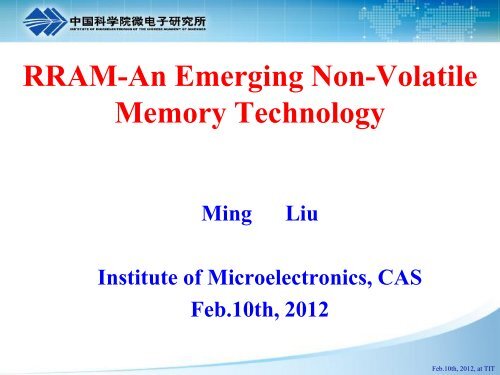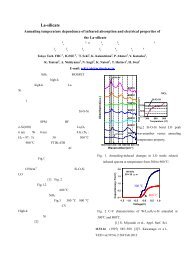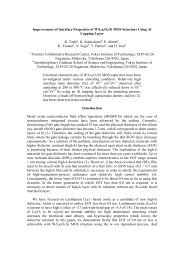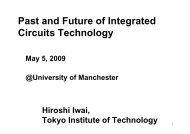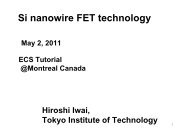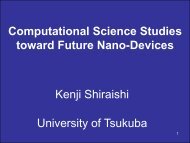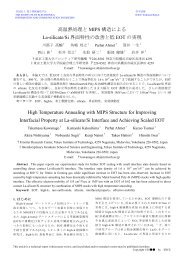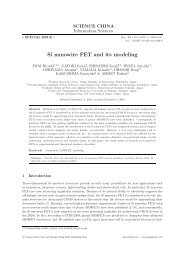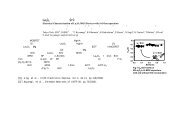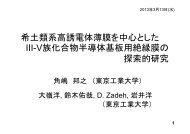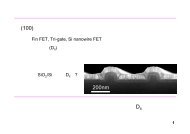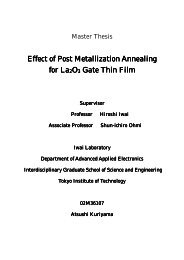RRAM - An Emerging Non-volatile Memory Technology
RRAM - An Emerging Non-volatile Memory Technology
RRAM - An Emerging Non-volatile Memory Technology
Create successful ePaper yourself
Turn your PDF publications into a flip-book with our unique Google optimized e-Paper software.
Flash <strong>Memory</strong>Concepts proposed by D.Kahng and S. M. Sze, Bell Lab,1967Kahng and S. M. Sze, Bell SystemsTechnical Journal 46 (1967) 1288.•Uses Fowler-Nordheim tunneling to erasethe memory•Uses CHE or FN to program the memory• The NVM bit information is representedby the change in Id-Vg curve of the readtransistorconnected to the floating gateDominated the NVM in the last two decades3Feb.10th, 2012, at TIT
Flash Scaling ChallengesPhysical limitations exist!–– leakage current–– High voltage operations–– Charge storage requirements of the dielectrics and reliability issues–– Slow writing speedYear 1999 2001 2003 2007 2009 2012 2015Node 180 nm 130 nm 90 nm 65 nm 45 nm 25 nm 16 nm?It is very hard for conventional Flash memory to go through 16 nm node!Feb.10th, 2012, at TIT
Outline‣ <strong>An</strong> overview of <strong>Non</strong>-<strong>volatile</strong> memory‣ <strong>RRAM</strong> technology: Opportunitiesand Challenges‣ <strong>RRAM</strong> research in IMECAS‣ SummaryFeb.10th, 2012, at TIT
Opportunities for <strong>RRAM</strong>Expected <strong>RRAM</strong> specsRequired memory specsWorking memoryEmbedded NVMStand-alone NVMWorking memoryEmbedded NVMStand-alone NVM<strong>RRAM</strong><strong>RRAM</strong> is not suitable for working memory, but quite competitive for embedded andstand-alone NVM application.Feb.10th, 2012, at TIT
Challenges for <strong>RRAM</strong>2. Which <strong>RRAM</strong> materials are worthy manufacturing? Contaminationfree, low thermal budget, acceptable performance,……Feb.10th, 2012, at TIT
Outline‣ <strong>An</strong> overview of <strong>Non</strong>-<strong>volatile</strong> memory‣ <strong>RRAM</strong> technology: Opportunitiesand Challenges‣ <strong>RRAM</strong> research in IMECAS‣ SummaryFeb.10th, 2012, at TIT
<strong>RRAM</strong> research in IMECAS• Switching Mechanism Study• Device performance improvement• Solution for 3D Integration• Statistics Modeling Work• IntegrationFeb.10th, 2012, at TIT
Solid-electrolyte-based <strong>RRAM</strong>CF formation process:i) anodic metal atoms (M) oxidizemetal ions (M z- ) according to thereaction (M → M z- + ze - )ii) the M z- cations migrate towardthe cathode under the high electricfield;iii) M z- deoxidize back to M andelectrodeposits on the surface of theinert electrode according to thereversed reaction (M z- + ze - → M)Ref. R. Waser, et. al., Adv. Mater., 21, 2009.Solid electrolyte materials: AgS, CuS, AgGeSe, SiO 2 , Ta 2 O 5 , ZrO 2 ,HfO 2 , ZnO, a-Si, …Feb.10th, 2012, at TIT
Conductive Filaments MechanismThe resistive switching phenomenaare dominated by conductivefilaments mechanism‣ The current slope is close to 1in ON state.‣ I Reset increases with increasingI Comp in Set process.‣ The resistance of ON state isinsensitive to the cell sizes.How to confirm the nature of filamentsis a trouble to <strong>RRAM</strong> researcher.W. Guan, S. Long, Q. Liu, M. Liu and W. Wang, IEEE Electron Devices Lett., 29, 5, 2008.Feb.10th, 2012, at TIT
Dependence on Temperature• In the LRS, thermal coefficient is 0.00298/K @ 293K (5×5μm), 0.00249/K @293K (10×10μm) and 0.00239/K @ 293 (20×20μm)• Thermal coefficient of Cu nanowire (>15nm) is 0.0025/K @ 293KConduction in LRS arises from copper metal!W. Guan, S. Long, M. Liu, Q. Liu, and W. Wang, Appl. Phys. Lett., 93, 223506, 2008.Feb.10th, 2012, at TIT
How many of CF?Step:1mV/stepStep:10uV/stepObserved a stair-like I-V by ultra low sweeping speed,demonstratedthe existence of multi filaments.Qi Liu, et al., Appl. Phys. Lett. 93, 023501 (2009)Feb.10th, 2012, at TIT
Electronic field simulationThe simulation of electric field distribution of CFs under different growth stages uses theMATLAB PDE-tool, (a) pre-connection (b) connect establishment and (c) postconnection.Simulating result indicate that multiple cylinder-like CFs will be formed inthe Cu-doped ZrO 2 film.Feb.10th, 2012, at TIT
Multiple Filaments MechanismThe stepwise switching behavior can be explained by multiple parallel filamentsare successively connected between the bottom and top electrodes during setprocess. The resistance steps in on-state follow the inverse relationship of formingsequence of these filaments, further verifying the multiple filaments mechanisms.Qi Liu, et al., Appl. Phys. Lett. 93, 023501 (2009)Feb.10th, 2012, at TIT
Fabrication technique for ReRAM TEM specimenFeb.10th, 2012, at TIT
Dynamic process of CF formation and ruptureReadSetResetQi Liu, et al., Advanced materials, acceptedFeb.10th, 2012, at TIT
Growth of the multiple conductive filamentSample 1Under voltage stress, the dynamitic growth of the conductive filament were observed inthe above movie. As can be seen from the video, there are two conductive filaments wereformed from the Cu to the Pt electrodes through the ZrO 2 layer.Feb.10th, 2012, at TIT
Dynamic process of CF formationIn oxide based electrolyte material,the metal bridge is found grown from theanode, rather than the cathode, which is opposite to the conventional PMC theory.Feb.10th, 2012, at TIT
Dynamic process of CF RuptureThe rupture process,from the cathode, also opposite to the conventionaltheory.(Qi Liu, et al., Advanced Materials accepted)Feb.10th, 2012, at TIT
CF growth by inserting nano-crystalionatom + + +Cu(Ag) TEi) anodic metal atoms (M) oxidizemetal ions (M z- ) according to thereaction (M → M z- + ze - )ZrO 2voxidedii) the M z- cations migrate towardthe cathode under the high electricfield, more M z- gathered around NC;reducedPt BEMetal NCiii) M z- deoxidize back to M andelectrodeposits on the surface of theinert electrode according to thereversed reaction (M z- + ze - → M)‣ Enhancing and converging the electrical field by metal NC‣ Accelerating metal ions velocity‣ Controlling filament growth location by metal NCQi Liu, et al., EDL 31(11) 1299Feb.10th, 2012, at TIT
Electric field simulation‣The maximum intensity of E at the NC tip‣The intensity of E rapidly decaysoutside the column region above the NClocation‣The maximum intensity of Eexponentially increase with the NC sizeQi Liu, et al., EDL 31(11) 1299Feb.10th, 2012, at TIT
TE/ZrO2/Cu NC/Ptclear Si waferthermal SiO 2 layerdeposit BE electrode materialsdeposit Cu thin film (3nm)TECu NC ZrO 2Pt electrodeTiSiO 2deposit ZrO 2 film (40 nm)rapid thermal annealing (600 o C, 5s, N 2 )defining TE electrode shapedeposit TE electrode materialslift-off to forming TE electrodeelectrical testQi Liu, et al., EDL 31(11) 1299Feb.10th, 2012, at TIT
Ag/ZrO 2 /Cu NC/PtTEM images CFTiPtPtCu NCCu NC~20 nmCFAgAuAgThe nano-bridge region is directly connected to a protrusion of thePt BE, and the protrusion is a Cu NC based on elements analysis byEDS!Qi Liu, et al., ACS Nano. 4, 6162 (2010)Feb.10th, 2012, at TIT
EDS analysisi) a→b corresponds to the Ag electrode region;ii) b→c corresponds to the CF electrode region;iii)c→d corresponds to the Cu NC region.Qi Liu, et al., ACS Nano. 4, 6162 (2010)Feb.10th, 2012, at TIT
Element mappingCu-KZr-LAg-LThe component of nano-bridge in the Ag/ZrO 2 /Cu NC/Pt device ismainly Ag elements ! Qi Liu, et al., ACS Nano. 4, 6162 (2010)Feb.10th, 2012, at TIT
Outline‣ <strong>An</strong> overview of <strong>Non</strong>-<strong>volatile</strong> memory‣ <strong>RRAM</strong> technology: Opportunitiesand Challenges‣ <strong>RRAM</strong> research in IMECAS‣ SummaryFeb.10th, 2012, at TIT
Summary Temperature-dependent switching characteristics reveals thatmicroscopic nature of the metallic conductive is Cu element inCu/BTMO:Cu/Pt based <strong>RRAM</strong>. Multiple resistance steps in Cu/BTMO:Cu/Pt device was observed,it is due to successively established parallel filaments between thebottom and top electrodes during Set process. We have indentified the metallic nature of CF in Cu/ZrOx/Ptdevice and observed the existence of multi-CFs Oxide-ElectrolytebasedReRAM. Adding a metal NC layer, CFs grow easily along the direction ofmetal NC, which reduces the randomness of the CF formationand rupture processes.Feb.10th, 2012, at TIT
Thanks for yourattention!Feb.10th, 2012, at TIT


